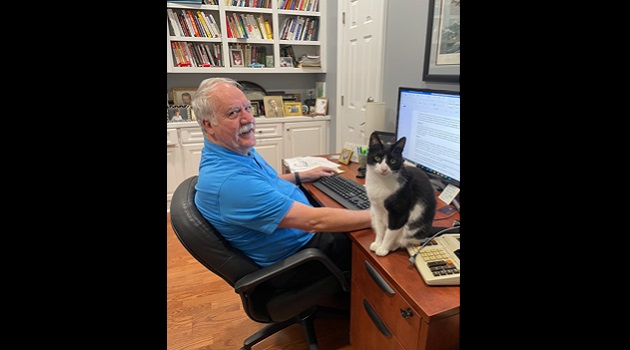By Mike DuBose with Dr. David Hurst, DVM
In our earlier article, we described how our pets bring us great joy and comfort, along with many physical and mental health benefits. Unfortunately, we will outlive our best friends. Animals leave our lives through a variety of ways such as tragic accidents or escaping and getting lost, while others succumb to diseases and injuries. According to research, while we often wish they would die a natural death while sleeping, few experience this peaceful path. Consequently, we are faced with making very difficult, often agonizing decisions when we have to decide how we help our loved ones leave us.
After adopting your pet, either through a formal non-profit agency, like Pawmetto Lifeline (Columbia, SC), or they show up at your back door, you want to develop relationships with veterinarians early on before you need them. Vets can provide preventable care, maintain your pet’s history, guide you through the animal’s life, and treat them as needed. Your veterinarian is dedicated to providing all means to keep your pet well. They will also be your final expert when the painful moment occurs and a decision is needed to extend your pet’s life or peacefully end suffering due to poor quality of life.
Based on our experience and interviews with many animal lovers and Vets, the process of deciding when to end your pet’s life is extremely difficult and uncertain—There is no right time. Ohio University School of Veterinary Science reports “The quality of animals’ lives is defined by their overall physical and mental well-being, not just one aspect of their lives. It is important to remember that all pets are different. What may be considered a poor quality of life for one may be different for another.”
And, extending the animal’s life when the end is near, you will be presented with different options such as: (1) Evaluation by your Vet using ultrasounds, X-rays, blood tests, and various treatments; (2) Referral to specialists like internists, oncologists, etc.; (3) Hospice-care programs that will allow family members time to say goodbye and ease their pet’s pain; and (4) Euthanasia (many refer to this procedure as “putting your pet down”).
The ability to pay for advanced evaluations and treatments can be expensive. One has to carefully assess if the goal is for your benefit of not wanting to part with your beloved pet and buying additional time. Are you focusing on the animal’s quality of life which is deteriorating? Most of the time, it’s a combination of both. Animal lovers will often mortgage their homes to keep their pets alive and well. But when do you finalize your decision that the end is nearing?
Vets often have different perspectives on guiding patients on end-of-life decisions. Dr. Alice Villalobos, the veterinarian who started Pawspice, a program for terminal pets, published an excellent on-line scoring system for life quality called “The HHHHHMM Scale.” You can type the assessment’s name into your computer Internet browser to obtain the free chart. The letters stand for: Hurt, Hunger, Hydration, Hygiene, Happiness, Mobility, and “More Good Days than Bad” on how to assess your pet’s well-being. Her research guides animal owners to rate their pet in 25 categories. We witnessed some of the behaviors by our pets as their lives were declining which include the animal: (1) Doesn’t want to play; (2) Interacts abnormally; (3) Doesn’t enjoy some of its past activities; (4) Hides as if it’s in pain; (5) Appears to not enjoy living; (6) Sleeps more than usual; (7) Seems depressed, inactive, and lethargic; (8) Experiences digestive problems such as vomiting and diarrhea; (8) Isn’t eating well or dehydrated; (9) Losing weight; and (10) Isn’t cleaning its coat which is matted, greasy, and unkept.
Our cat, Jett, recently experienced some of these symptoms and we thought his time was up. Our two Veterinarians (Drs. Mundell and Hurst) put their heads together and didn’t give up! Through a variety of evaluations, treatments, medications, and prayer, his normal life was restored.
Dr. Marty Becker summarized our thoughts by her excellent comments: “We are so fortunate that our dogs and cats are living longer than ever before and have access to the highest levels of veterinary care. At some point, though, just as with people, nothing more can be done. That doesn’t mean that euthanasia must be the next step. More people are turning to end-of-life programs that help to ease a pet’s journey out of life that maintains comfort, while giving the family extra time with him. Pet owners and veterinarians should work together to increase survival time, ensure the quality of life, relieve pain, and recognize when it’s time to say goodbye. That philosophy of maintaining quality of life honors the human-animal bond.”
The Bottom Line: There are many variables one has to weigh when their beloved animal enters its final stages of life. Pet owners should carefully explore different options with their Vet. When Veterinarians say, “We have done everything we can do,” prepare everyone to say their “Final Goodbyes.” We recommend that you spend quality time with them, ensure they are without pain, and love them. And, yes, it’s OK to cry and grieve with your best friend during this sad time.
Our next article will outline the steps in preparation when the final, dreadful decision for them to depart has been made.
The DuBose family’s purpose is to “Create Opportunities to Improve Lives.” Mike is a staff member with USC’s graduate school. In 1987, he founded his family of companies and eventually wrote the book “The Art of Building Great Businesses.” Visit his nonprofit website www.mikedubose.com for free access to his books and 100+ published articles, including business, travel, and personal topics, in addition to health research with Surb Guram, MD.
Dr. Hurst is a licensed veterinarian with Friarsgate Animal Hospital in Columbia, SC. He is a graduate of Newberry College and the University of Georgia’s College of Veterinary Medicine.


